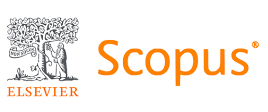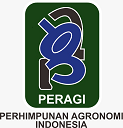Chitosan as A Plant Pathogen Control Agent: A Review
Abstract
Pathogen attacks can cause decreased yields, even crop failure. Proper control can suppress pathogens' development and maintain yields. The concept of integrated pest management emphasizes the application of several techniques, one of which is the use of organic products as vegetable pesticides. Chitosan is a natural product obtained from crustacean shells or skins which can be used in various fields, including agriculture. Indonesia is one of the countries producing raw products from crustacean animals (shrimp, crab, lobster, and squid). This also has an impact on the amount of shell or skin waste produced. The processing of crustacean animal skin waste into chitosan can go through several stages, namely deproteinized, demineralization, and deacetylation. Chitosan application can be done by seed treatment, foliar spraying, soil application, and post-harvest products. The mode of action of chitosan against pathogenic fungi is binding to phospholipids in the plasma membrane of fungal cells, causing changes in hyphal morphology, degrading fungal enzymes, increasing levels of phenolics, sugar, and proline, and activating antimicrobial compounds and defense-related enzymes. The modes of action against pathogenic bacteria are interfering with gene expression, causing cell lysis, destroying bacterial biofilms, increasing defense enzyme activity, inducing systemic resistance, damaging and changing cell membranes, and causing cell wall permeability. The mode of action against pathogenic viruses is to increase the expression of genes related to defense, inhibit systemic viral multiplication and hypersensitivity response. The utilization of chitosan products is very important to study, especially in suppressing the use of chemical products and maintaining ecosystem sustainability.
Keywords
Full Text:
PDFReferences
Abdelkhalek, A., Qari, S. H., Abu-Saied, M. A. A. R., Khalil, A. M., Younes, H. A., Nehela, Y., & Behiry, S. I. (2021). Chitosan nanoparticles inactivate alfalfa mosaic virus replication and boost innate immunity in nicotiana glutinosa plants. Plants, 10(12). https://doi.org/10.3390/plants10122701
Abdellatef, M. A. E., Elagamey, E., Kamel, S. M., Abdellatef, M. A. E., Elagamey, E., & Kamel, S. M. (2022). Chitosan Is the Ideal Resource for Plant Disease Management under Sustainable Agriculture. Chitin-Chitosan - Isolation, Properties, and Applications Eds. Dr. Brajesh Kumar. https://doi.org/10.5772/INTECHOPEN.107958
Agusta, I. (2021). Ekstraksi Kitosan Dari Limbah Kulit Udang Dengan Proses Deasetilasi. CHEMTAG Journal of Chemical Engineering, 2(2), 38. https://doi.org/10.56444/cjce.v2i2.1935
Akter, J., Jannat, R., Hossain, M. M., Ahmed, J. U., & Rubayet, M. T. (2018). Chitosan for Plant Growth Promotion and Disease Suppression against Anthracnose in Chilli. International Journal of Environment, Agriculture and Biotechnology, 3(3), 806–817. https://doi.org/10.22161/ijeab/3.3.13
Ali, H., Baehaki, A., & Lestari, S. D. (2017). Karakteristik Edible Film Gelatin-Kitosan dengan Tambahan Ekstrak Genjer (Limnocharis flava) dan Aplikasi pada Pempek. Jurnal FishtecH, 6(1), 26–38. https://doi.org/10.36706/fishtech.v6i1.4449
Ali, M., Nisak, F., & Ika Pratiwi, Y. (2020). Pemanfaatan Limbah Cair Ikan Tuna Terhadap Pertumbuhan Tanaman Pakchoy Dengan Wick System Hydroponik. Agro Bali: Agricultural Journal, 3(2), 186–193. https://doi.org/10.37637/ab.v3i2.616
Amalia, & Arga, N. (2018). Pemanfaatan Cangkang Rajungan sebagai Koagulan untuk Penjernih Air [Universitas Islam Indonesia]. https://dspace.uii.ac.id/bitstream/handle/123456789/8337/FULL LAPORAN TA ARGA NAYESYA A..pdf?sequence=1
Arafat, A., Samad, S., & Masum, S. (2015). Preparation and characterization of chitosan from shrimp shell waste. International Journal of Scientific & Engineering Research, 6(5), 538–541. https://www.researchgate.net/profile/Sabrin-Samad/publication/282641814_Preparation_and_Characterization_of_Chitosan_from_Shrimp_shell_waste/links/5614cd6808aed47facee936c/Preparation-and-Characterization-of-Chitosan-from-Shrimp-shell-waste.pdf
Azhar, M., Efendi, J., Syofyeni, E., Marfa Lesi, R., & Sri Novalina, dan. (2010). Pengaruh Konsentrasi NaOH dan KOH Terhadap Derajat Deasetilasi Kitin Dari Limbah Kulit Udang. EKSAKTA, 1(0).
Bastaman, S. (1989). Warta IHP / J . of Agro-Based Industry Degradation and Extraction of Chitin and Chitosan from Shells of Prawn ( Nephrops norvegicus ) Mempelajari Proses Degradasi dan Ekstraksi Chitin dan Chitosan dari Kulit Udang ( Nephorps norvegicus ) Syarif Bastaman T. Warta IHP Journal of Agro Based Industry, 6(2), 1–6.
Chandra, S., Chakraborty, N., Panda, K., & Acharya, K. (2017). Chitosan-induced immunity in Camellia sinensis (L.) O. Kuntze against blister blight disease is mediated by nitric-oxide. Plant Physiology and Biochemistry, 115, 298–307. https://doi.org/10.1016/j.plaphy.2017.04.008
Coutinho, T. C., Ferreira, M. C., Rosa, L. H., de Oliveira, A. M., & Oliveira Júnior, E. N. de. (2020). Penicillium citrinum and Penicillium mallochii: New phytopathogens of orange fruit and their control using chitosan. Carbohydrate Polymers, 234(October 2019), 115918. https://doi.org/10.1016/j.carbpol.2020.115918
Damayanti, T. A., Haryanto, H., & Wiyono, S. (2013). Pemanfaatan Kitosan Untuk Pengendalian Bean Common Mosaic Virus (Bcmv) Pada Kacang Panjang. Jurnal Hama Dan Penyakit Tumbuhan Tropika, 13(2), 110–116. https://doi.org/10.23960/j.hptt.213110-116
Dodgson, J. L. A., & Dodgson, W. (2017). Comparison of effects of chitin and chitosan for control of Colletotrichum sp. on cucumbers. Journal of Pure and Applied Microbiology, 11(1), 87–93. https://doi.org/10.22207/JPAM.11.1.12
El Gamal, A. Y., Atia, M. M., Sayed, T. El, Abou-Zaid, M. I., & Tohamy, M. R. (2022). Antiviral activity of chitosan nanoparticles for controlling plant-infecting viruses. South African Journal of Science, 118(112), 1–9. https://doi.org/10.17159/sajs.2022/10693
El Hadrami, A., Adam, L. R., El Hadrami, I., & Daayf, F. (2010). Chitosan in plant protection. Marine Drugs, 8(4), 968–987. https://doi.org/10.3390/md8040968
Firmansyah, D., . W., & Hidayat, S. H. (2017). Chitosan and Plant Growth Promoting Rhizobacteria Application to Control Squash mosaic virus on Cucumber Plants. Asian Journal of Plant Pathology, 11(3), 148–155. https://doi.org/10.3923/ajppaj.2017.148.155
Hamdayanty, Yunita, R., Amin, N. N., & Damayanti, T. A. (2016). Pemanfaatan Kitosan untuk Mengendalikan Antraknosa pada Pepaya (Colletotrichum gloeosporioides) dan Meningkatkan Daya Simpan Buah. Jurnal Fitopatologi Indonesia, 8(4), 97–102. https://doi.org/10.14692/jfi.8.4.97
Hameed, A., Sheikh, M. A., Hameed, A., Farooq, T., Basra, S. M. A., & Jamil, A. (2014). Chitosan seed priming improves seed germination and seedling growth in wheat (Triticum aestivum L.) under Osmotic Stress Induced by Polyethylene Glycol. Philippine Agricultural Scientist, 97(3), 294–299.
Hastuti, S., Arifin, S., & Hidayati, D. (2012). Pemanfaatan Limbah Cangkang Rajungan (Portunus pelagicus) Sebagai Perisa Makanan Alami. Agrointek : Jurnal Teknologi Industri Pertanian, 6(2), 88–96. https://doi.org/10.21107/AGROINTEK.V6I2.1978
Hesami, A., Kavoosi, S., Khademi, R., & Sarikhani, S. (2021). Effect of chitosan coating and storage temperature on shelf-life and fruit quality of Ziziphus mauritiana. International Journal of Fruit Science, 21(1), 509–518. https://doi.org/10.1080/15538362.2021.1906825
Hussein, M. A. M., Baños, F. G. D., Grinholc, M., Dena, A. S. A., El-Sherbiny, I. M., & Megahed, M. (2020). Exploring the physicochemical and antimicrobial properties of gold-chitosan hybrid nanoparticles composed of varying chitosan amounts. International Journal of Biological Macromolecules, 162, 1760–1769. https://doi.org/10.1016/j.ijbiomac.2020.08.046
Jia, X., Meng, Q., Zeng, H., Wang, W., & Yin, H. (2016). Chitosan oligosaccharide induces resistance to Tobacco mosaic virus in Arabidopsis via the salicylic acid-mediated signalling pathway. Scientific Reports, 6(April), 1–12. https://doi.org/10.1038/srep26144
Kou, S. G., Peters, L., & Mucalo, M. (2022). Chitosan: A review of molecular structure, bioactivities and interactions with the human body and micro-organisms. Carbohydrate Polymers, 282, 119132. https://doi.org/10.1016/j.carbpol.2022.119132
Laflamme, P., Benhamou, N., Bussières, G., & Dessureault, M. (2000). Differential effect of chitosan on root rot fungal pathogens in forest nurseries. Canadian Journal of Botany, 77(10), 1460–1468. https://doi.org/10.1139/cjb-77-10-1460
Li, B., Liu, B., Su, T., Fang, Y., Xie, G., Wang, G., Wang, Y., & Sun, G. (2010). Effect of Chitosan Solution on the Inhibition of Pseudomonas fluorescens Causing Bacterial Head Rot of Broccoli. The Plant Pathology Journal, 26(2), 189–193. https://doi.org/10.5423/PPJ.2010.26.2.189
Li, B., Shi, Y., Shan, C., Zhou, Q., Ibrahim, M., Wang, Y., Wu, G., Li, H., Xie, G., & Sun, G. (2013). Effect of chitosan solution on the inhibition of Acidovorax citrulli causing bacterial fruit blotch of watermelon. Journal of the Science of Food and Agriculture, 93(5), 1010–1015. https://doi.org/10.1002/jsfa.5812
Li, B., Wang, X., Chen, R., Huangfu, W., & Xie, G. (2008). Antibacterial activity of chitosan solution against Xanthomonas pathogenic bacteria isolated from Euphorbia pulcherrima. Carbohydrate Polymers, 72(2), 287–292. https://doi.org/10.3390/molecules17067028
Li, S., & Zhu, T. (2013). Biochemical response and induced resistance against anthracnose (C olletotrichum camelliae) of camellia (C amellia pitardii) by chitosan oligosaccharide application. Forest Pathology, 43(1), 67–76. https://doi.org/10.1111/j.1439-0329.2012.00797.x
Lipsa, F. D., Ursu, E. L., Ursu, C., Ulea, E., & Cazacu, A. (2020). Evaluation of the antifungal activity of gold-chitosan and carbon nanoparticles on fusarium oxysporum. Agronomy, 10(8), 1–11. https://doi.org/10.3390/agronomy10081143
Long, L. T., Tan, L. Van, Boi, V. N., & Trung, T. S. (2018). Antifungal activity of water‐soluble chitosan against Colletotrichum capsici in postharvest chili pepper. Journal of Food Processing and Preservation, 42(1), e13339. https://dx.doi.org/10.1016/j.carres.2011.04.042
Lou, M.-M., Zhu, B., Muhammad, I., Li, B., Xie, G.-L., Wang, Y.-L., Li, H.-Y., & Sun, G.-C. (2011). Antibacterial activity and mechanism of action of chitosan solutions against apricot fruit rot pathogen Burkholderia seminalis. Carbohydrate Research, 346(11), 1294–1301.
Ma, Z., Yang, L., Yan, H., Kennedy, J. F., & Meng, X. (2013). Chitosan and oligochitosan enhance the resistance of peach fruit to brown rot. Carbohydrate Polymers, 94(1), 272–277. https://dx.doi.org/10.1016/j.carbpol.2013.01.012
Ministry of Maritime Affairs and Fisheries. (2012). Statistik Perikanan Tangkap, Perikanan Budaya dan Ekspor – Impor Setiap Provinsi Seluruh Indonesia. Ministry of Maritime Affairs and Fisheries. https://statistik.kkp.go.id/home.php?m=eksim&i=211#panel-footer
Ministry of Maritime Affairs and Fisheries. (2015). Limbah Kitin Yang Bernilai Tambah | KKP News. Ministry of Maritime Affairs and Fisheries.
Ministry of Maritime Affairs and Fisheries. (2022a). Total Produksi. Produksi Perikanan 2020-2021. Ministry of Maritime Affairs and Fisheries. Ministry of Maritime Affairs and Fisheries
Ministry of Maritime Affairs and Fisheries. (2022b). Total Produksi. Produksi Perikanan 2020-2021. Https://Statistik.Kkp.Go.Id/Home.Php?M=prod_ikan_prov&i=2#panel-Footer.
Mishra, S., Kavi, S., Palliath, U., & Sagar, P. (2014). Biocontrol of tomato leaf curl virus (ToLCV) in tomato with chitosan supplemented formulations of Pseudomonas sp. under field conditions. AJCS 8 (3): 347 – 355.
Munhuweyi, K., Caleb, O. J., Lennox, C. L., van Reenen, A. J., & Opara, U. L. (2017). In vitro and in vivo antifungal activity of chitosan-essential oils against pomegranate fruit pathogens. Postharvest Biology and Technology, 129, 9–22. https://doi.org/10.1016/j.scienta.2017.03.038
Nagorskaya, V., Reunov, A., Lapshina, L., Davydova, V., & Yermak, I. (2014). Effect of chitosan on tobacco mosaic virus (TMV) accumulation, hydrolase activity, and morphological abnormalities of the viral particles in leaves of N. tabacum L. cv. Samsun. Virologica Sinica, 29, 250–256. https://doi.org/10.1007/s12250-014-3452-8
Nerdy, N., Lestari, P., Simorangkir, D., Aulianshah, V., Yusuf, F., & Bakri, T. K. (2022). Comparison of chitosan from crab shell waste and shrimp shell waste as natural adsorbent against heavy metals and dyes. Int. J. Appl. Pharm, 14, 181–185. https://doi.org/10.22159/ijap.2022v14i2.43560
Ningtyas, K., Muslihudin, M., & Elsyana, V. (2021). Isolation and characterization chitosan from varied crab shell. International Conference on Agriculture and Applied Science, November, 41–44. https://doi.org/10.25181/icoaas.v1i1.2008
Oliveira, J., Enio, N. de, Melo, Itamar, S. de, Franco, & Telma, T. (2012). Changes in hyphal morphology due to chitosan treatment in some fungal species. Brazilian Archives of Biology and Technology, 55, 637–646. https://doi.org/10.1590/S1516-89132012000500001
Onaran, A., Bayar, Y., Karakurt, T., Tokatlı, K., Bayram, M., & Yanar, Y. (2021). Antifungal activity of chitosan against soil-borne plant pathogens in cucumber and a molecular docking study. Journal of Taibah University for Science, 15(1), 852–860. https://doi.org/10.1080/16583655.2021.2006434
Pangaribuan, D. H., Widagdo, S., Ginting, Y. C., Saputri, I. P., & Fathulloh, M. (2023). Pengaruh POC Rumput Laut sebagai Substitusi Nutrisi AB Mix pada Tanaman Sawi (Brassica juncea L.) dengan Sistem Hidroponik. Agro Bali : Agricultural Journal, 6(3), 608–620. https://doi.org/10.37637/ab.v6i3.1069
Ramkissoon, A., Francis, J., Bowrin, V., Ramjegathesh, R., Ramsubhag, A., & Jayaraman, J. (2016). Bio‐efficacy of a chitosan based elicitor on Alternaria solani and Xanthomonas vesicatoria infections in tomato under tropical conditions. Annals of Applied Biology, 169(2), 274–283. https://doi.org/10.1111/aab.12299
Rinaudo, M. (2012). Physical properties of chitosan and derivatives in sol and gel states. Chitosan‐Based Systems for Biopharmaceuticals: Delivery, Targeting and Polymer Therapeutics, 23–43. https://doi.org/10.1002/9781119962977.ch2
Septiana, S., Ratih, S., & Evizal, R. (2018). Kajian Kitosan Sebagai Agens Pengendali Penyakit Busuk Buah Kakao (Phytophthora megakarya L.). Jurnal Agro Industri Perkebunan, 6(2), 61–66. https://doi.org/10.25181/jaip.v6i2.977
Siddaiah, C. N., Prasanth, K. V. H., Satyanarayana, N. R., Mudili, V., Gupta, V. K., Kalagatur, N. K., Satyavati, T., Dai, X. F., Chen, J. Y., Mocan, A., Singh, B. P., & Srivastava, R. K. (2018). Chitosan nanoparticles having higher degree of acetylation induce resistance against pearl millet downy mildew through nitric oxide generation. Scientific Reports, 8(1), 1–14. https://doi.org/10.1038/s41598-017-19016-z
Sitorus, R. F., Karo-Karo, T., & Lubis, Z. (2014). Pengaruh konsentrasi kitosan sebagai edible coating dan lama penyimpanan terhadap mutu buah jambu biji merah. Jurnal Rekayasa Pangan Dan Pertanian, 2(1), 37–46.
Sreelatha, S., Kumar, N., Yin, T. S., & Rajani, S. (2022). Evaluating the Antibacterial Activity and Mode of Action of Thymol-Loaded Chitosan Nanoparticles Against Plant Bacterial Pathogen Xanthomonas campestris pv. campestris. Frontiers in Microbiology, 12(January), 1–11. https://doi.org/10.3389/fmicb.2021.792737
Suryadi, Y., Priyatno, T. P., Samudra, I. M., Susilowati, D., Sriharyani, T. S., & Syaefudin. (2017). Control of Anthracnose Disease (Colletotrichum gloeosporioides) Using Nano Chitosan Hydrolyzed by Chitinase Derived from Burkholderia cepacia Isolate E76 (Pengendalian Penyakit Antraknosa [Colletotrichum gloeosporioides] Menggunakan Kitosan Nano Hasil Hid. 13(2), 111–122.
Suryadi, Y., Susilowati, D., Samudra, I. M., & Priyatno, T. P. (2019). Pengaruh Aplikasi Kitosan Antifungi Untuk Pengendalian Penyakit Antraknosa Pada Cabai. Jurnal Pertanian Tropik, 6(1), 108–118. https://jurnal.usu.ac.id/index.php/Tropik.
Tanasale, M. F. J. D. P., Killay, A., & Laratmase, M. S. (2012). Kitosan dari Limbah Kulit Kepiting Rajungan (Portunus sanginolentus L.) sebagai Adsorben Zat Warna Biru Metilena. Jurnal Natur Indonesia, 14(1), 165. https://doi.org/10.31258/jnat.14.1.165-171
Trisnawati, E., Andesti, D., Saleh, A., Raya Palembang Prabumulih Km, J., & Ogan Ilir, I. (2013). Pembuatan Kitosan Dari Limbah Cangkang Kepiting Sebagai Bahan Pengawet Buah Duku Dengan Variasi Lama Pengawetan. In Jurnal Teknik Kimia, 19( 2).
Uge, E., & Cahyaningrum, H. (2019). Kinerja Kitosan sebagai Agen Pengimbas Ketahanan Tanaman terhadap Virus Patogen. Jurnal Pengkajian Pertanian, 8(1), 25.
Uge, E., Sulandari, S., Hartono, S., & Somowiyarjo, S. (2018). The Effect of Chitosan Application against Plant Growth and Intensity of Stunting Disease on Black Pepper (Piper nigrum L.) Seedlings. Jurnal Perlindungan Tanaman Indonesia, 22(2), 224. https://doi.org/10.22146/jpti.25453
Vijayan, S., Divya, K., Varghese, S., & Jisha, M. S. (2020). Antifungal Efficacy of Chitosan-Stabilized Biogenic Silver Nanoparticles against Pathogenic Candida spp. Isolated from Human. BioNanoScience, 10(4), 974–982. https://doi.org/10.1007/s12668-020-00781-7
Widiantini, F., Purnama, A., Yulia, E., & Formanda, D. (2016). Keefektifan Oligochitosan dalam Menekan Pertumbuhan Jamur Patogen Rigidoporus lignosus [(Klotzsch) Imazeki] Penyebab Penyakit Jamur Akar Putih pada Tanaman Cengkeh secara in Vitro. Agrikultura, 27(1), 59–64. https://doi.org/10.24198/agrikultura.v27i1.8477
Xing, K., Zhu, X., Peng, X., & Qin, S. (2015). Chitosan antimicrobial and eliciting properties for pest control in agriculture: a review. Agronomy for Sustainable Development, 35(2), 569–588. https://doi.org/10.1007/s13593-014-0252-3
Xue, H., Yang, Z., Xue, H., & Yang, Z. (2021). Potato Dry Rot Caused by Fusarium spp. and Mycotoxins Accumulation and Management. Fusarium - An Overview of the Genus. https://doi.org/10.5772/INTECHOPEN.100651
Yang, C., Li, B., Ge, M., Zhou, K., Wang, Y., Luo, J., Ibrahim, M., Xie, G., & Sun, G. (2014). Inhibitory effect and mode of action of chitosan solution against rice bacterial brown stripe pathogen Acidovorax avenae subsp. avenae RS-1. Carbohydrate Research, 391, 48–54. https://doi.org/10.1016/j.carres.2014.02.025.
Zheng, F., Zheng, W., Li, L., Pan, S., Liu, M., Zhang, W., Liu, H., & Zhu, C. (2017). Chitosan controls postharvest decay and elicits defense response in kiwifruit. Food and Bioprocess Technology, 10, 1937–1945. https://doi.org/10.1007/s11947-017-1957-5.
Refbacks
- There are currently no refbacks.


























